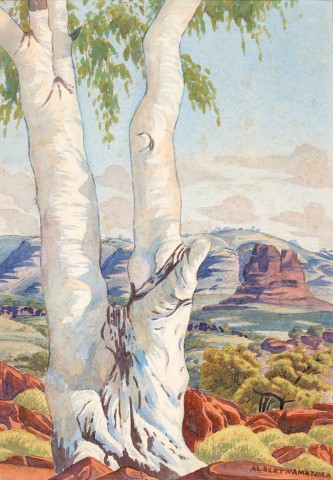THE GHOST GUM OF PALM VALLEY, c.1943
ALBERT NAMATJIRA
watercolour and pencil on card
38.5 x 27.0 cm
signed lower right: ALBERT NAMATJIRA
Private collection
Leonard Joel, Melbourne, 12 April 1989, lot 205
Private collection, Melbourne
The Ghost Gum of Palm Valley, 1942, illus. in Mountford, C.P., The Art of Albert Namatjira, Bread and Cheese Club, Melbourne, 1945, p. 35
‘He was definitely the beginning of a recognition of Aboriginal people by white Australia’.1
The first Indigenous artist to achieve both local and international renown, Albert Namatjira is heralded as the pioneer of contemporary Indigenous art in Australia through his groundbreaking depictions of desert locations in the Western MacDonnell Ranges that fuse European pictorial techniques and methods with a deep ancestral connection to his Arrente country. Today synonymous with our vision of the Australian outback, Namatjira’s art nevertheless experienced many vicissitudes over the course of the last century. Although his first solo exhibition in 1938 at the Fine Arts Society in Melbourne was a sell-out success, with popularity and fame continuing throughout his lifetime, praise for Namatjira’s skillful adaptation of a Western medium was inevitably accompanied by a bitter twist; his paintings ‘…were appreciated because of their aesthetic appeal, but they were at the same time a curiosity and sign that Aborigines could be civilised’.2 Ironically such perceived ‘assimilation’ would later bring his art into disrepute with Namatjira virtually ignored by the Australian art establishment during the 1960s and 70s. Fortunately, the Papunya Tula Aboriginal art ‘renaissance’ and cultural politics of reconciliation during the 80s prompted long overdue reassessment of Namatjira’s unique contribution. More recently, he has accordingly received the recognition he so deserves with three biographies published, and three major exhibitions mounted by public galleries, including a retrospective at the National Gallery of Australia in 2002 to celebrate the centenary of his birth, Seeing the Centre: The Art of Albert Namatjira 1902-1959.
Like many of Namatjira’s finest works, The Ghost Gum of Palm Valley, c.1943 evokes the artist’s distinctive compositional type with his much-loved, luminous white ghost gum typically dominating the foreground, silhouetted against a dramatic, brilliantly coloured backdrop of distant mountain ranges. Balanced on the left side of the composition and reaching beyond the picture, the majestic gum plays a pivotal role not only as a framing device and point of entry into the picture plane. More fundamentally perhaps, the signature cropped tree motif creates a tangible sense of being present in the landscape, of participating alongside the artist in seeing and identifying with the land – thus imbuing the work with an unmistakable intimacy, notwithstanding the panoramic view and monolithic forms. For while immortalising an ostensibly Western-style topographical view of the Central Australian landscape in all its myriad moods and rich textures, such depictions also resonate with important personal symbolism for the artist as statements of belonging – coded expressions embodying the memory and sacred knowledge of a traditional ancestral site, his ‘dreaming’ or totem place.
1. Charles Perkins, quoted on the 7.30 Report: McLaughlin, M., ‘A Report on the Life of Albert Namatjira’, 7.30 Report, Australian Broadcasting Corporation (ABC), broadcast, 3 July 2002.
2. Morphy, H., Aboriginal Art, Phaidon Press, Australia, 1998, p. 270
VERONICA ANGELATOS
